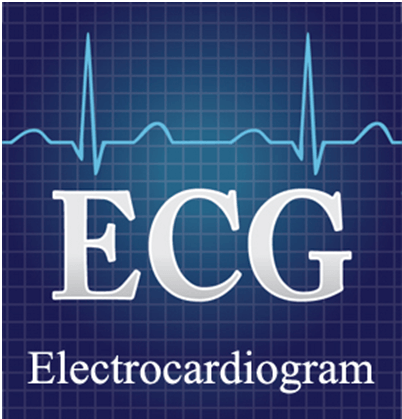What is the full form of ECG
ECG: Electrocardiogram
ECG stands for Electrocardiogram. It refers to a test that is performed to check the electrical activity of the heart. The normal electrical activity indicates that the heart is working normally.

ECG records the electrical impulses when the heart is beating. These impulses are recorded on a moving strip of paper or on a screen, i.e. it shows heart’s electrical activity as line tracings on paper. The spikes and dips that appear in the tracings are called waves. So, a normal ECG line tracing consists of waves which are as follows:
P Wave: It is the first upward movement of the ECG tracing. It shows the electrical activity of the upper hear chambers.
QRS Complex: It consists of three waves that begin with a downward deflection (Q) then a large upward deflection (R), and then a downwards S wave. It shows the electrical activity of the lower heart chambers.
ST Segment: It appears as a straight line when the ventricle contracts without any electrical impulse.
T Wave: It is a modest upwards wave that represents ventricular repolarization, i.e. when the lower heart chambers are preparing for next muscle contraction.
If there is any problem with hearts? rhythm, there will be variation in the pattern of impulses or the graph. It is a painless procedure. It is performed by placing electrodes at specific places on your body like arms, legs or chest.
Why is an ECG needed?
ECG can detect various heart-related problems, some are listed below;
- A heart attack in the past (myocardial infarction)
- Abnormal heart rhythms
- Cause of unexplained chest pain
- Enlargement of one side of the heart
- Thickness of the walls of the heart chambers
- Restricted blood supply to heart due to cholesterol deposits
- To check the performance of implants like pacemaker
- To check the heart’s health if a person is suffering high cholesterol, diabetes, high blood pressure, etc.
Types of ECG: There are three main types of ECG which are as follows;
Resting ECG: It is carried out when the patient is lying down in a comfortable position.
Stress or Exercise ECG: It is carried out when you are using a treadmill or exercise bike.
Ambulatory ECG: The patient is required to wear a small machine at his or her waist. The patient may go home and resume his or her routine work. It helps monitor the heart for one or more days.
